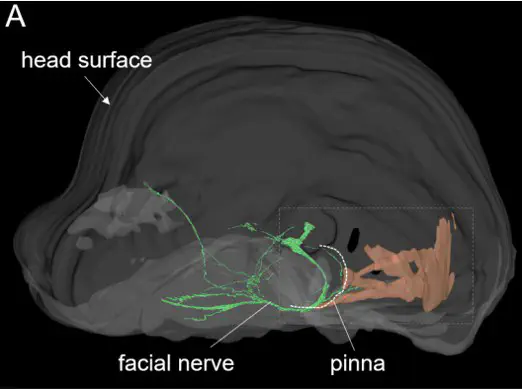Anatomy and homology of the caudal auricular muscles in greater short-nosed fruit bat (Cynopterus sphinx)

Abstract
Bats can be phylogenetically classified into three major groups: pteropodids, rhinolophoids, and yangochiropterans. While rhinolophoids and yangochiropterans are capable of laryngeal echolocation, pteropodids lack this ability. Delicate ear movements are essential for echolocation behavior in bats with laryngeal echolocation. Caudal auricular muscles, especially the cervicoauricularis group, play a critical role in such ear movements. Previously, caudal auricular muscles were studied in three species of bats with laryngeal echolocation, but to our knowledge, there have been no studies on non-laryngeal echolocators, the pteropodids. Here, we describe the gross anatomy of the cervicoauricularis muscles and their innervation in Cynopterus sphinx by using diffusible iodine-based contrast-enhanced computed tomography and 3D reconstructions of immunohistochemically stained serial sections. A previous study on bats with laryngeal echolocation reported that rhinolophoids have four cervicoauricularis muscles and yangochiropterans have three. We observed three cervicoauricularis muscles in the pteropodid C. sphinx. The number of cervicoauricularis muscles and their innervation pattern were comparable to those of non-bat boreoeutherian mammals and yangochiropterans, suggesting that pteropodids, and yangochiropterans maintain the general condition of boreoeutherian mammals and that rhinolophoids have a derived condition. The unique nomenclature had been previously applied to the cervicoauricularis muscles of bats with laryngeal echolocation, but given the commonality between non-bat laurasiatherians and bats, with the exception of rhinolophoids, maintaining the conventional nomenclature (i.e., M. cervicoauricularis superficialis, M. cervicoauricularis medius, and M. cervicoauricularis profundus) is proposed for bats.Chi, T.-C., Meguro, F., Takechi, M., Furutera, T., Tu, V.T., Higashiyama, H., Sohn, J., Nojiri, T., Kimura, J., Koyabu, D.
The Journal of Veterinary Medical Science (2023)